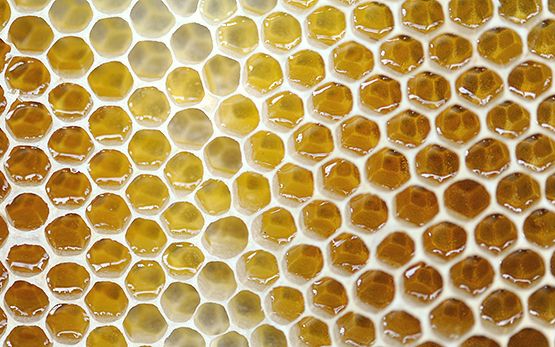Der Wassergehalt des von den Pflanzen produzierten Nektars kann variieren. Um seine Konservierung in den Waben zu gewährleisten, darf er nicht gären. Deshalb wird er von den Bienen in Honig umgewandelt, indem sie seinen Wassergehalt senken und folglich den Zuckergehalt erhöhen. Dies verhindert die Entwicklung der Mikroorganismen. In der Dunkelheit des Bienenstocks ist es schwierig, den Herstellungsprozess des Honigs zu beobachten. Aus diesem Grund ist er auch nur wenig erforscht. Um die Umwandlung von Nektar in Honig zu untersuchen, haben wir die Technik der Tomographie eingesetzt. Sie ermöglicht es, den Zuckergehalt des eingelagerten Nektars sehr präzise zu messen, ohne den Bienenstock öffnen zu müssen und das Bienenvolk zu stören.

Numero del progetto: 22.16.19.06.01
Modelli di biodiversità nello spazio e nel tempo
Basierend auf Monitoringdaten wird in diesem Projekt der Zustand und die Veränderung der Biodiversität im Agrarraum ermittelt und damit abgeschätzt, ob die Umweltziele Landwirtschaft im Bereich Biodiversität erreicht werden. Ebenso liegt ein Fokus auf der Evaluation der Biodiversitätsförderflächen und deren Beitrag zur Erreichung der Umweltziele. Gleichzeitig werden im Projekt Einflussfaktoren analysiert oder deren Effekt auf die Biodiversität experimentell untersucht. Ein weiterer Schwerpunkt liegt in der Entwicklung neuer, effizienter Methoden zur Erfassung der Biodiversität im Agrarraum. Das Projekt soll eine breite Wirkung in der Verwaltung, Öffentlichkeit, Interessengruppen im Bereich Umwelt und Landwirtschaft und der Wissenschaft haben. Es soll eine zentrale Grundlage sein, um die Massnahmen, welche die Biodiversität im Agrarraum fördern, zu überprüfen und zu optimieren.
ID-Progetto: 3821 Inviare via e-mail
Responsabile del progetto
Sostituta/o
| Cognome, Nome | Sede |
|---|---|
| Dieker Petra | Reckenholz |
| Herzog Felix | Reckenholz |
| Herzog Chantal | Reckenholz |
| Knop Eva | Reckenholz |
| Meier Eliane | Reckenholz |
| Neff Felix | Reckenholz |
| Winizki Jonas | Reckenholz |
Malmagro R., García-Navas V., Priyadarshana T. S., Neff F., Barrios P., Martínez-Núñez C.
The productivity gradient explains global bird specialisation better than climate stability.
Global Ecology and Biogeography, 34, (8), 2025, Articolo e70107.
Crosnier A., Baudry G., Jeangros L., Meier E., Cisco G., Spring L., Barjolle D.
True cost accounting for food application: Environmental, social and health impacts of bread.
Journal of Cleaner Production, 524, 2025, Articolo 146224.
Meier E., Indermaur A., Knop E.
Biodiversity-friendly landscapes: A paradox for conservation?
Science Advances, 11, (30), 2025, Articolo eadt9564.
Mupepele A.C., Hellwig N.M., Dieker P., Klein A.M.
What evidence exists on wild bee trends in Germany?: A systematic map.
Environmental Evidence, 14, 2025, Articolo 11.
Reji Chacko M., Albouy C., Altermatt F., Casanelles-Abella J., Brändle M., Boussange V., Campell F., Ellis W. N., Fopp F., Gossner M. M., Ho H.-C., Joss A., Kipf P., Neff F., Petrović A. e altri
A species-level multi-trophic metaweb for Switzerland.
Scientific Data, 12, 2025, Articolo 1164.
Reji Chacko M., Albouy C., Altermatt F., Boussange V., Brändle M., Farwig N., Gossner M. M., Ho H.-C., Joss A., Neff F., Pellissier L.
Species loss in key habitats accelerates regional food web disruption.
Communications Biology, 8, 2025, Articolo 988.
Grognuz V., Landolt F., Curty J., Knop E.
Slugs hide in the dark: Artificial light at night alters fitness and activity of dominant herbivores with consequences for ecosystem functioning.
iScience, 28, (6), 2025, Articolo 112770.
Meier E., Lüscher G., Herzog C., Herzog F., Indermaur A., Winizki J., Knop E.
Veränderung der Biodiversität in der Schweizer Agrarlandschaft: Von der ALL-EMA-Ersterhebung (2015–2019) zur Zweiterhebung (2020–2024).
Agroscope Science, 209, 2025, 1-84.
Neff F., Chittaro Y., Korner-Nievergelt F., Litsios G., Rey E., Knop E.
Moth communities are shaped by season, weather, elevation, and landscape composition.
Insect Conservation and Diversity, 18, (4), 2025, 670-680.
Indermaur A.
Felddatenerhebung ALL-EMA: Methodenbeschreibung Version 4.0.
Agroscope Science, 201, 2025, 1-39.
altre lingue:
Herzog C., Meier E., Knop E.
Scheda – Rilevamento / Osservazione a lungo termine: Programma di monitoraggio «Specie e habitat nell’agricoltura» (ALL-EMA).
Agroscope. 2025, 2 pp.
altre lingue:
Sperandii M. G., Bazzichetto M., Götzenberger L., Moretti M., Achury R., Blüthgen N., Fischer M., Hölzel N., Klaus V. H., Kleinebecker T., Neff F., Prati D., Bolliger R., Seibold S., Simons N. K. e altri
Functional traits mediate the effect of land use on drivers of community stability within and across trophic levels.
Science Advances, 11, (4), 2025, Articolo eadp6445.
Neff F., Chittaro Y., Korner-Nievergelt F., Litsios G., Martínez-Núñez C., Rey E., Knop E.
Data and codes for the analysis of moth trends in Switzerland over 50 years in dependence of elevation.
Zenodo, Dataset, 2024
Stöckli S., Chevillat V., Rutz T., Saussure S., Pfiffner L.
Was leisten Landwirtschaftsbetriebe in der Schweiz für die Erhaltung der Biodiversität?
Agrarforschung Schweiz, 15, 2024, 313-321.
Razanajatovo M., Schurr F.M., Muhthassim N., Troesch S., Knop E.
Pollen load, pollen species diversity and conspecific pollen carried by pollinators across 24-hour cycles.
Basic and Applied Ecology, 78, 2024, 23-27.
Knop E., Dominoni D.
Sensory pollution by artificial light: Implications for ecology and evolution.
Basic and Applied Ecology, 78, 2024, 39-40.
Meier E., Lüscher G., Herzog F., Birrer S., Plattner M., Knop E.
Mehr Biodiversität dank Biodiversitätsförderflächen in Vernetzungsprojekten.
Agrarforschung Schweiz, 15, 2024, 168-175.
Herzog C., Meier E., Schneuwly J., Birrer S., Roth T., Knop E.
Effekte ausgewählter Faktoren auf die Biodiversität in Schweizer Agrarlandschaften.
Agrarforschung Schweiz, 15, 2024, 128-137.
Martinez-Nuñez C., Gossner M., Maurer C., Neff F., Obrist M., Moretti M., Bollmann K., Herzog F., Knop E., Luka H., Cahenzli F., Albrecht M.
Land‐use change in the past 40 years explains shifts in arthropod community traits.
Journal of Animal Ecology, 93, (5), 2024, 540-553.
Meier E., Lüscher G., Herzog F., Knop E.
Collaborative approaches at the landscape scale increase the benefits of agri-environmental measures for farmland biodiversity.
Agriculture, Ecosystems & Environment, 367, 2024, 1-9.
Knop E., Grimm M. L., Korner-Nievergelt F., Schmid B., Liechti F.
Patterns of high-flying insect abundance are shaped by landscape type and abiotic conditions.
Scientific Reports, 13, 2023, 1-8.
Blösch S., Albrecht M., Jenny M., Streit B., Knop E.
Rows make the field: Winter wheat fields with manipulated crop architecture show potential for ecological intensification based on higher natural pest and week seed control.
Agriculture, Ecosystems & Environment, 348, 2023, 1-11.
Blösch S., Zellweger J., Batary P., Knop E.
A systematic review on the effectiveness of crop architecture-related in-field measures for promoting ground-breeding farmland birds.
Journal for Nature Conservation, 76, 2023, 1-7.
Ecker K. T., Meier E., Tillé Y.
Integrating spatial and ecological information into comprehensive biodiversity monitoring on agricultural land.
Environmental Monitoring and Assessment, 195, (10), 2023, 1-20.
Herzog C., Meier E., Lüscher G., Knop E.
Integration externer Datensätze führt zu neuen Erkenntnissen: Arten und Lebensräume Landwirtschaft (ALL-EMA).
Hotspot, 47, 2023, 29-30.
altre lingue:
Neff F., Prati D., Achury R., Ambarlı D., Bolliger R., Brändle M., Freitag M., Hölzel N., Kleinebecker T., Knecht A., Schäfer D., Schall P., Seibold S., Staab M., Weisser W. W. e altri
Reduction of invertebrate herbivory by land use is only partly explained by changes in plant and insect characteristics.
Ecological Monographs, 93, (2), 2023, 1-26.
Casanelles-Abella J., Fontana S., Meier E., Moretti M. , Fournier B.
Spatial mismatch between wild bee diversity hotspots and protected areas.
Conservation Biology, 37, (4), 2023, 1-16.
Le Provost G., Schenk N., Penone C., Thiele J., Westphal C., Allan E., Ayasse M., Blüthgen N., Boeddinghaus R., Boesing A., Bolliger R., Busch V., Fischer M., Gossner M., Hölzel N. e altri
The supply of multiple ecosystem services requires biodiversity across spatial scales.
Nature Ecology & Evolution, 7, 2023, 236-249.
Herzog C., Meier E., Indermaur A., Winizki J., Lüscher G., Knop E.
Specie e habitat in agricoltura – Censimento della diversità nel paesaggio agricolo.
Agroscope, Zürich. Aprile, 2022, 8 pp.
altre lingue:
Hölker F., Bolliger J., Davies T.W., Giavi S., Jechow A., Kalinkat G., Longcore T., Spoelstra K., Tidau S., Visser M.E., Knop E.
11 pressing research questions on how light pollution affects biodiversity.
Frontiers in Ecology and Evolution, 9, 2022, 1-13.
Liu Y., Speisser B., Knop E., van Kleunen M.
The Matthew effect: Common species become more common and rare ones become more rare in response to artificial light at night.
Global Change Biology, 28, (11), 2022, 3674-3682.
Lüscher G., Meier E., Plattner, M., Roth, T.
Die Pflanzen- und Tagfaltervielfalt profitiert von Biodiversitätsförderflächen im Grünland - Ist das genug?
N+L Inside, 4, 2022, 30-34.
Neff F., Korner-Nievergelt F., Rey E., Albrecht M., Bollmann K., Cahenzli F., Chittaro Y., Gossner M. M., Martinez Nunez C., Meier E., Monnerat C., Moretti M., Roth T., Herzog F., Knop E.
Different roles of concurring climate and regional land-use changes in past 40 years’ insect trends.
Nature Communications, 13, 2022, 1-12.
Knop E., Meier E.
Synergien mit ALL-EMA.
Hotspot, Sonderheft, 2022, 41-41.
Neff F., Hagge J., Achury R., Ambarlı D., Ammer C., Schall P., Seibold S., Staab M., Weisser W., Gossner M.
Hierarchical trait filtering at different spatial scales determines beetle assemblages in deadwood.
Functional Ecology, 36, (12), 2022, 2929-2942.
Huber N., Ginzler Ch., Pazur R., Descombes P., Baltensweiler A., Ecker K., Meier E., Price B.
Countrywide classification of permanent grassland habitats at high spatial resolution.
Remote Sensing in Ecology and Conservation, 9, (1), 2022, 133-151.
Meier E., Lüscher G., Knop E.
Disentangling direct and indirect drivers of farmland biodiversity at landscape scale.
Ecology Letters, 25, (11), 2022, 2422-2434.
Neff F., Lehmann M., Moretti M., Pellissier L., Gossner M.
Tracking sucking herbivory with nitrogen isotope labelling: Lessons from an individual trait-based approach.
Basic and Applied Ecology, 63, 2022, 104-114.
Maeder M., Guo X., Neff F., Schneider Mathis D., Gossner M. M.
Temporal and spatial dynamics in soil acoustics and their relation to soil animal diversity.
PLOS ONE, 17, (3), 2022, e0263618.






